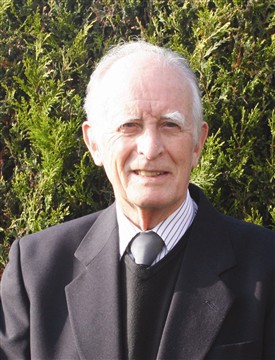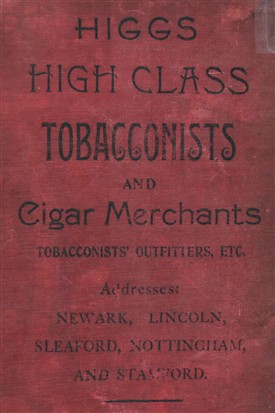Part 2

George Harper - author

An advert for Higgs' tobacconists who supplied 1000 pipes as 'comforts' for the Farndon troops
Farndon in the Great War
By George Harper
The Village of Farndon and the Great War
Part 2
In Part 1 of this article I dealt chiefly with the mobilisation of the local T.A. Battalion of the Sherwood Foresters on the outbreak of war and the recruitment drive which followed as the need for increased manpower became apparent.
Army pay and the raising of money through the Prince of Wales to alleviate hardship of the men and their families still left gaps which had to be filled by other means.
Very early on Colonel Huskinson was concerned with the morale of the men under his command, and his thoughts turned to pipes and pipe-smoking to fill in the moments of leisure and boredom of service life. He launched an appeal through Battalion headquarters for donations of pipes and sure enough a local firm (Messrs Higgs “Tobacconists and Suppliers of Smokers’ Requisites’) soon sent 1000 pipes, valued at £25 for which gifts the Colonel expressed his thanks publicly.
Christmas comforts for the troops.
Christmastime gifts are a well-known way by which the morale of the troops was raised at the time. Queen Mary’s tins of chocolate and other items for the troops figure in numerous small museums of war-time memorabilia.
Knitting ‘comforts for the troops’ such as socks, scarves and pullovers was another way in which civilians at home could supplement official army issue. Children were also organised and encouraged through day school and Sunday school to do their bit and I have in my collection of mementos a certificate passed on to me by the late Mrs Kathleen Hordle. It was presented to her sister Winnie Pearson (later Winnie Botherway after her marriage) and is worded:
“The Overseas Club
Patron His Majesty The King
Christmas Day Gifts from the School Children of the Empire”
It certifies that Winnie Pearson has helped to bring happiness on Christmas Day to our brave sailors and soldiers who are fighting for honour, freedom and justice. It is a pleasing and well-designed certificate and must have brought considerable pleasure and pride to the children receiving it.
Local egg collection.
The Mayoress of Newark instituted an egg collection from across a wide area in the locality to augment the diet of the servicemen who were patients in hospitals. Farndon seems to have averaged about 2 dozen a week, which was not the lowest total.
One of our local young ladies (Miss Lord, who might have been either the Winifred Lord on our War Memorial or her sister) received an unexpected letter of appreciation in September 1916, published in the local paper. Clearly the young lady in question had written her name and address on the shell of the egg she sent.
The letter ran as follows:
“Dear Miss Lord
I hope you are keeping well and doing good work for the sick and wounded in hospitals. I am sure we are grateful to anyone who supplies us with things, especially in the eatable line. I have been in hospital two and a half months and am enjoying life all right although I am 400 miles from home. I hope you won’t think me rude for writing to you. I am writing because you asked on the egg I received for breakfast this morning. Sincerely Yours, A Scotch Kiltie. “
This comes as a poignant message across the years from a man who, judging by the date may well have been a casualty on the Somme.
So many references at this time serve as reminders of what was to come In World War II. Those senior citizens who might remember ‘Spitfire Weeks’ in the 1940s would be familiar with the concept of the ‘Tank Week in January 1918. To assist the Nottingham drive to raise money for more tanks, Farndon Parish Council approved a house-to-house collection to swell the contribution.
Farndon School formed a War Savings Association with the Headmaster Mr J. Harrison as Hon Treasurer to raise money through a Savings Scheme towards helping the war effort. In February 1918 it was announced that over £63 had been raised (approximately £2,500 in modern terms).
The war in the Air.
No, Farndon wasn’t a victim of a rain of death from bombing by Zeppelins, but because of the damage and casualties caused by bombing raids in other parts of the country, people were naturally a bit twitchy.
One man with concern for the community was the Rev. Sparkes, the then Vicar of Farndon. He wrote a letter to the ‘Advertiser’ in June 1916 relating how he had been in his garden (at the Old Vicarage which was then his official residence) when he had counted about 20 distant explosions. In his own words he wrote “The impressions they gave me was that Zeppelins were busy, and that the explosions were the sounds of their bombs on some east coast town”. So, like some Air Raid Wardens 25 years later, he walked up the village to check that all the lights were out. One householder had a bright light shining through his window “so I told him to put his light out for I thought the Zeppelins were about the coast”.
On another occasion a Zeppelin did pass over Farndon on a clear starlit night and a resident named Stan Foster fetched all the customers out of the ‘Rose and Crown’ to watch it pass over the village.
A more darkly humorous story which appeared in the ‘Newark Advertiser’ concerned panic on the streets in Newark. A dark menacing shape accompanied by a twinkling bright light appeared in the sky and people were apparently expecting a Zeppelin to release its bombs. Until a group of boy scouts came along and pointed out that the light was an unusually bright display of the planet Jupiter and the menacing dark shape was a cloud formation.
Finally, to demonstrate that ‘Health and Safety’ is not just a modern concern, at a Church Vestry meeting the parishioners had to be reassured that the church WAS insured for the costs of damage caused by Zeppelin raids.
The village no doubt displayed an increasingly sombre atmosphere which deepened within a year of the outbreak of war. It wasn’t “all over by Christmas” as the optimists had predicted. Casualties quickly began to mount, and as news of the growing losses reached the families at home they quickly reached a wider public through the pages of the ‘Newark Advertiser’ and the ‘Newark Herald’.
Details appeared under the heading of “The Stricken Brave” or “The Fallen Brave”. These columns usually, though not always, took the form of a brief summary of personal background service record and often a photograph of the men concerned. The first Farndon casualty was young James McNaught Davies who on the outbreak of war abandoned his university studies and dashed up to Farndon on his motorbike in a hurry to get involved before it was all over. He enlisted as an officer in the South Wales Borderers and was killed by a sniper’s bullet in January 1915 whilst supervising a trenching party.
Throughout the war there must have been an eerie empty sort of atmosphere when you consider that throughout the war 125 of the menfolk were in the services at a time when the population of the village was in the region of 700.
Just when it seemed that things could not get worse they got worse. Not only was news from the Western Front increasingly bad, but the civilian population increasingly found itself being caught up in the consequences of German U boat warfare and growing shortages of food and other commodities.
At one point in 1916 it was calculated that there was only a six weeks of wheat which prompted the government to compel the cultivation of 2.5 million more acres for growing foodstuffs. Coal was rationed, the amount allocated being proportional to the number of rooms in the house.
By 1918 a situation developed which would become familiar to those who lived during the Second World War with the rationing of meat, butter, cheese, margarine and sugar. Householders were issued with ration books, families had to register with particular suppliers for their rations and there were severe penalties for breaches of the law.
The fighting on the Western Front reached its critical point in this year. After a desperate final push by the Germans which threatened at one point to sweep the allied forces back to the Channel coast, the enemy break-through lost its momentum, the entry of the United States into the war against Germany heralded the possibility of large numbers of fresh troops reinforcing the war-weary British and French and the enemy negotiated an Armistice which came into force at 11.00 a.m. on November 11th. 1918. The war was over, but the consequences were to last long into the post-war period.
George Harper
BACK to Part 1
FORWARD to Part 3
This article first appeared in the December 2013 edition of 'Farndon Focus', and is reproduced here (in a slighly edited form) by kind permission of the author and the magazine's editor.